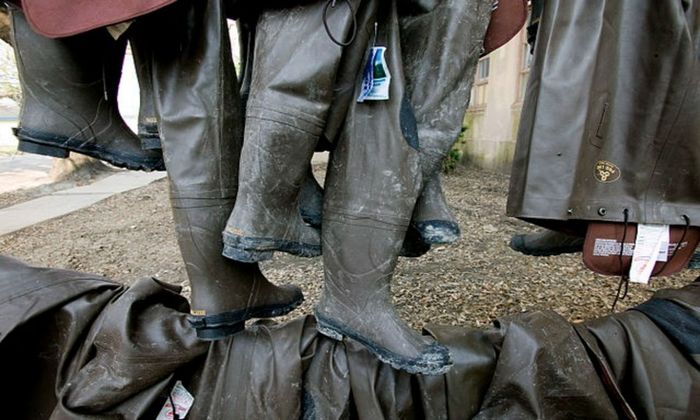10 Safety Tips for Fly Fishers
These 10 safety tips will help keep any fly fisher away from danger; whether it's from the water, the fish, or themselves.

Even though fly fishing can be a relaxing way to spend time on the water, it’s a very skillful form of fishing that can also double as a good workout. It’s not akin to traditional fishing because you need specially designed gear and equipment, and you need to have a different mindset. Fly fishing takes time and practice, but in no time at all, you can be a savant.
Whether you’re new to the technique or have already done it plenty of times, it’s still important to know the proper fly fishing etiquette, basic safety tips, and procedures. Here is a simple fly fishing guide about what you need to know:
Before Heading Out
1. Check the Weather
If you don’t check the updated weather forecast and conditions of where you’re planning to fly fishing, you may end up with a ruined day of angling. An angler and a fly fisher should always check the weather before heading out to plan for the conditions they could face ahead of time. Checking the weather can also inform you what you need to bring regarding clothing, gear, and equipment.

If you see and hear lightning and thunder, the best thing to do is to remove yourself from the water ASAP. Take cover and continue casting and catching fish if you’re not hearing thunder in at least 30 minutes. The National Weather Service endorses this protocol.
2. Dress and Pack Up Accordingly

As previously mentioned, knowing the weather conditions can inform you how to dress and pack up. Fly fishing can be done in many areas with varying needs. The best thing to do is always bring rubber boots or waders, gloves, a hat, and extra layers of clothing just in case the weather conditions get unpredictable or other random things happen. Having eyewear can also protect you from direct sunlight and from the possibility of hitting the hook in your eyes.
The other thing that should be at the top of your list is extra drinking water. This is to lessen the risk of dehydration when the climate is warmer and the risk of contracting diseases like giardia from river water.
Other necessary and valuable things you should bring are sunscreen and bug spray. No matter what weather or season you’re experiencing, always wear sunscreen. You can also get a Swiss Army knife, a GPS, a compass, a flashlight, and most importantly, a phone (in case you need to contact someone for emergencies.)
3. Check the Water Conditions
Because fly fishing is mostly done in rivers, it’s a good idea to check for their stream flows. You can look up almost all United States rivers’ stream flows online. If you find a river flowing too quickly, you may need to cancel or try to find another river.
4. Bring a Buddy
Bringing someone with you increases your chances of having a safe fly fishing trip. If one of you experiences something unfortunate, at least you’ll know that you’re not alone and there’s someone ready to help.

While You’re Fly Fishing
5. Mark Your Path
Some destinations may require you to go through a hike or trek. Mark your path and entry point so you can remember where you’ve been, and you’ll be less likely to get lost and be disoriented. This is especially helpful if you’re planning to stay out until dark.
6. Wading Safety
Trust your instincts when it comes to the water levels and currents. If you’re unsure, don’t continue to wade into the water. A good rule is that you shouldn’t wade into the water past your calf. Once you’ve established, you can safely wade a river, cross it at an upstream angle and ensure your foot is secured on the river bottom before taking a step.
7. Hook Safety
Always use barbless hooks or pinch any barbed hooks. This is to make it easier and less painful to remove if it gets caught in your body after casting or while trying to remove the fish you’ve caught.
8. Fish Safety
Most fly fishing areas and fly fishers practice catch and release fishing. Because of this, you must know how to handle fish properly without harming them.
Before handling fish, make sure your hands are wet and that the fish won’t come in contact with dry clothing. Use a knotless or rubber net when landing fish and remove the fish quickly from the hook while it’s in water. When you’re lifting the fish out of the water, always hold it in a manner in which it can support its weight. Don’t grip too hard if you’re holding them by the tail. To release the fish, revive it by holding its head upstream until it begins moving.
9. Watercraft Safety
Watercraft can refer to vessels such as boats, kayaks, kick-boats, and float tubes. First and foremost, always have a lifejacket or life vest on board for everyone in the vessel. Also, have a personal flotation device. Have a marine whistle and other signaling devices that can help you call for help in an emergency. If you plan to fish in the dark, ensure your vessel is attached with lights on all sides.
10. Understanding the Patterns and the Environment
One of the important things for a fly fisher is to be observant of their surroundings. Fly fishing is a specific skill that requires patience. Making a reckless decision could impact your safety. Don’t break your arm because you didn’t learn about proper fly fishing forms. Remember to balance the use of your body and don’t put all the pressure on one joint or muscle when you’re catching fish with bait, wet fly, dry fly, or an artificial fly.
Don’t be foolish when it comes to water, either. Don’t try to fight the current, and don’t attempt to soldier on when it’s giving you a hard time. Being patient and waiting things out is sometimes the best course of action. No fish is worth getting hurt over or worth drowning for.



